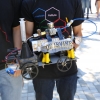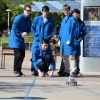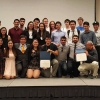 April 22, 2016 - A chemical typically used in crime scene investigations ended up providing the solution a team of engineering students had been searching for. After coming in second in last year’s American Institute of Chemical Engineers (AIChE) regional Chem-E Car competition, the UC Irvine team swept 13 other schools in this year’s contest, taking first place in both the on-track and poster presentation events.
April 22, 2016 - A chemical typically used in crime scene investigations ended up providing the solution a team of engineering students had been searching for. After coming in second in last year’s American Institute of Chemical Engineers (AIChE) regional Chem-E Car competition, the UC Irvine team swept 13 other schools in this year’s contest, taking first place in both the on-track and poster presentation events.
The annual Chem-E Car Western Region competition, held this year at UC Riverside, tasks students to design and build a car powered by chemical energy. The vehicle, no larger than 30 by 40 centimeters, must safely carry a specified load over a given distance in two minutes, and stop autonomously using only a chemical reaction. The challenge is intensified because teams do not know the load volume or the required distance the car must travel until minutes before the competition begins.
Instead of revamping last year’s car, the team started anew. They scratched the idea of battery power, choosing instead to use a fuel cell in SteVIe, named (for the sixth consecutive year) for team muse Steve Weinstock, the Samueli School’s chemical engineering and materials sciences lab manager. They tossed their old stopping mechanism too (an iodine clock, used by almost all the other teams), replacing it with a novel Luminol-bleach reaction. Luminol, the chemical used to identify blood and other crime scene evidence, glows brightly when it’s oxidized by the bleach. When a sensor detects that the light from the reaction has reached a certain level, an Arduino program triggers the car’s stopping mechanism.
The required distance for this year’s competition was 18 meters, and the car that got closest to that target was the winner. SteVIe stopped successfully at 18.04 meters – just 4 centimeters off the mark – besting the second-place team’s effort by more than a foot.
(A second UCI team also competed; their car, named Steve’s Pride, finished in the top half.)
SteVIe’s victory didn’t come without a nerve-racking setback. Each team has two chances to run the course, and during the first round, SteVIe’s stopping mechanism triggered too early. An undetected leak in the apparatus had caused the chemical reaction to occur too soon, stopping the car at just 8.6 meters.
The team had about 30 minutes between rounds to figure out what went wrong and try to fix it. They discovered that a waxy seal called the parafilm had been attached too tightly and that a syringe used to add bleach to the Luminol solution was sticking, not allowing the proper concentration to be pumped into the stopping gear. In addition, the solution’s exposure to light had degraded it slightly.
Instead of panicking, the team’s “engineers’ instinct” kicked in, says second-year Samueli School chemical engineering student Sara Steinhauser, who described the mood in the lab as “what-went-wrong-let’s-fix-it.” They wrapped aluminum foil around the exposed part of the stopping mechanism to protect it from light and heat, and lubricated the syringe. “It was good to go for the next round,” Steinhauser says.
The team’s on-track triumph was sweetened by their win in the poster category. One of the team’s two managers, Christine Nguyen, says their poster was “very professional-looking,” and that the three judges appeared impressed by their unique luminal-and-bleach-fueled stopping mechanism. “It stood apart from everyone else’s.”
“I think they were really interested in that because I don’t think it’s been used in a Chem-E car before,” says fourth-year student Ethan Boado, who was tasked with presenting the poster to the judges.
The other factor that set SteVIe apart from the competition was its starting mechanism, says the team’s other manager, Noah McFerran. Instead of relying on batteries like most of the other cars, the team used a hydrogen fuel cell. But there was a twist. A new contest rule required teams using hydrogen to manufacture the gas themselves, not purchase it as previously had been allowed. And the hydrogen had to be produced at atmospheric pressure – under 5 psi.
“It ended up meaning that we made our own apparatus to produce hydrogen at atmospheric pressure, and we had to design our own pump” to get the hydrogen into the car, McFerran says.
The team felt well-prepared for whatever contingencies the contest would throw its way. The car’s sensors, calibration, chemistry and programming made it “smart, very smart,” according to Boado. “We can write all the variables – load, surface conditions, wind, amount of power, etc. – into the equation and it will tell us how far the car will go,” he says.
Safety is an important part of the competition. Each car must undergo a safety inspection before it’s allowed on the track, and SteVIe passed with flying colors. “We had to create new solutions that are safe and effective, and we did that,” says Boado.
The team’s double victory was well-earned. Since January, members have worked 20 hours a week in the lab, designing, developing and fine-tuning the car and the chemistry that powers it. The week before the April 16-17 competition, McFerran says, they worked close to 100 hours. “We were in the lab until 6 a.m. on the last day,” he adds.
“I’m very proud of the team for representing our school and working hard together,” says Hung Nguyen, assistant professor and the team’s faculty adviser. “They volunteered their own time working late in the evening and many weekends to come up with such a winning design, which reflects their tremendous tenacity and amazing problem-solving skills.”
Team members say they are well-positioned to cap their victory with another at the national competition, scheduled for November in San Francisco. Last year’s national winner missed the distance goal by three centimeters, just one centimeter better than SteVIe did at the regional contest. “If we can tighten it up and get it consistent, we’re easily number one,” Boado says.
- Anna Lynn Spitzer



